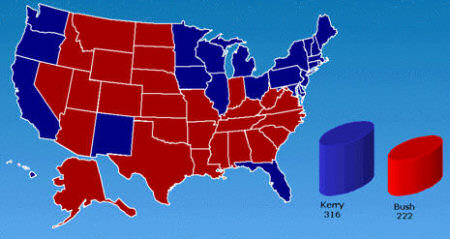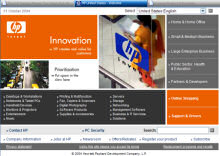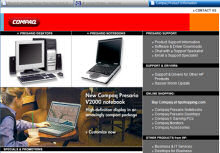Oh no…….four more years.
I’m wide awake
I’m wide awake
Wide awake
I’m not sleeping
Oh, no, no, no […]This desparation
Dislocation
Separation
Condemnation
Revelation
In temptation
Isolation
Desolation
Let it go
U2 – Bad

Oh no…….four more years.
I’m wide awake
I’m wide awake
Wide awake
I’m not sleeping
Oh, no, no, no […]This desparation
Dislocation
Separation
Condemnation
Revelation
In temptation
Isolation
Desolation
Let it go
U2 – Bad
[via Web Rank Info – in French]
Web Rank Info, one of the most interesting and active French website / forum specialized in Search Engines (Google, Yahoo!, etc), published a summary of a presentation made by Jeff Dean, a Google engineer who gave some inputs about the Google’s infrastructure during a colloquium at the University of Washington. You can also have a look at the entire video presentation (about 1 hour).
You got it? You have a factor 2.7 between both estimations, with a huge difference in the delivered power, if the software architecture is able to use this distributed infrastructure correctly.
Really impressive! And a good confirmation of the competitive advantage Google built with its infrastructure and platform (see my article about the Google’s platform)
Last polling forecast for the American Election from a great blog called “Cahier des Amériques” (in French) from G. Bouchez (journalist). It gives some hope. Let’s see tomorrow….

Good article from the MIT Technology Review about the launch of the Mozilla Foundation’s browser – Firefox v1.0 – on November 9, 2004.
Of course, the open-source community is masterful at the art of hyperbole. But it’s also pretty masterful at building products that users—not companies—demand. That’s due in large part to the fact that it’s the users—not companies—that build the products.
Firefox brings innovations to browser software that haven’t been since, well, since Microsoft and Netscape were trying to out-feature each other back in 1997. From little things like a local weather-related icon sitting in the page status space to the concept of tabbed pages, which make it possible to open multiple Web pages in the same window. This feature feels like a natural evolution in browsing—the ability to jump between pages within the same browser window (as opposed to opening multiple windows or continually hitting the back button).
Very “proud” to announce you that I received my first comment spam yesterday evening :-( Only positive thing: I could test the comment admin tool which is integrated in blogkomm from Holger. As usual, very nice!
 Knowledge@Wharton published an analysis – The H-P Compaq Merger Two Years Out: Still Waiting for the Upside – about the results of the merge between Hewlett-Packard and Compaq for a while. Interesting to see that there are still two different entry points for the new company (hp.com, compaq.com)…
Knowledge@Wharton published an analysis – The H-P Compaq Merger Two Years Out: Still Waiting for the Upside – about the results of the merge between Hewlett-Packard and Compaq for a while. Interesting to see that there are still two different entry points for the new company (hp.com, compaq.com)…


Different quite opposite views are expressed in this, which shows that it is still difficult to know after 2 years is this huge merge was/is worth or not.
George Day
“Wall Street may say, “Break the damn thing up’. Analysts [often] have good insights, but they made the same proposal in 1992 when Gerstner came on board. It’s a nice parallel. Gerstner was confronted, when he first arrived, with the idea of, ‘Let’s break up IBM into six or seven different businesses.’ Well, it would have been the worst possible decision for IBM. If Carly’s going to make this thing work, she’s going to have to do something like Gerstner did: pull things together and create solutions at the level of market segments. Each part of the organization that reaches the customer should have the autonomy to pull together whatever the customer wants, supported by product groups. That’s not a bad strategy. H-P is really a product-centric company. If they can move to become a customer-focused company, with the products feeding into those customer groups, then they may have a chance. But the problem with that strategy is we have a player [IBM] that’s already done that. HP is trying to be cost competitive with Dell and be the same kind of integrated-solutions provider that IBM has become. If that doesn’t work — if it’s clear IBM has too big a lead — then HP, which has this hugely profitable printer business, has to think about breaking up.”
Saikat Chaudhuri
“H-P has to be more focused on its marketing, not just saying, ‘We provide everything,’ but ‘We can cater to all your needs and this is how were going to do it.’ The beautiful part of IBM’s e-Business strategy is everything else can revolve around it. The challenge for H-P is to extend its brand. High quality and innovation need to apply to servers, services and storage systems as well as PCs.”

[thanx Patrick]
A description of the most important Google advanced search operators.
[via dragos]
Have a look at this entrepreneurial story. Interesting values (they called them “precepts”):
I must say that I agree a *lot* with these “precepts”. The only strange thing is that the guys sold the company one year after having defined these values… A pity in a way?
Wow, I’m back home after three *very* intensive days in our so-called “Management Forum”. As explained on Wednesday, this is our yearly group-wide Executive Managers meeting (Board of Directors and local Executive Board members, special Group functions). Near all the strategic workshops and presentations (some very interesting guest-speakers), these 3 days are a great opportunity for me to discuss with all my internal clients. All in all, I had exactly 15 (!) meetings. And a lot of great contacts with some quite impressive leaders (as usual, not all of our managers are leaders ;-).
Surely my best and more productive Management Forum (it was the third one).
The main strategic topic was … world ageing. Incredible, it was really fascinating. I can tell you, we all underestimate the impact of demography (ageing!) on our society … and the business opportunities generated by this development. I will present you a little bit more in the coming days.
In this field, it was interesting to observe how the age distribution looks like for the managers involved in the Management forum:
– 10% under 40
– 50% between 40 and 50
– 40% over 50
I was the only one under 35 (I’m 32) and the youngest, sometimes I feel a little bit alone ;-)